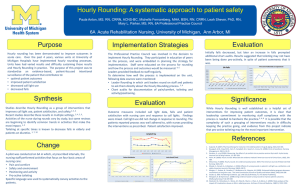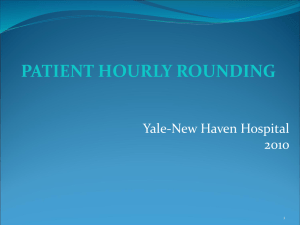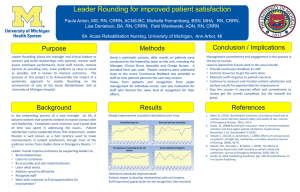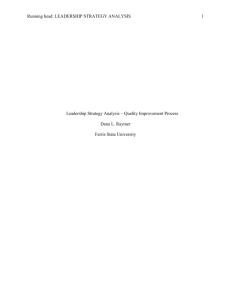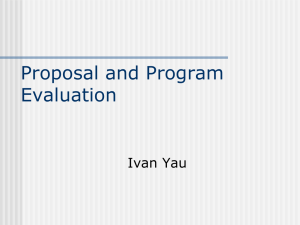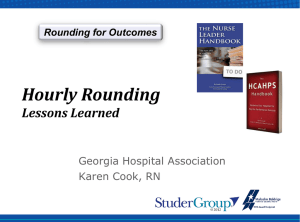Presentation - Quality & Health
advertisement
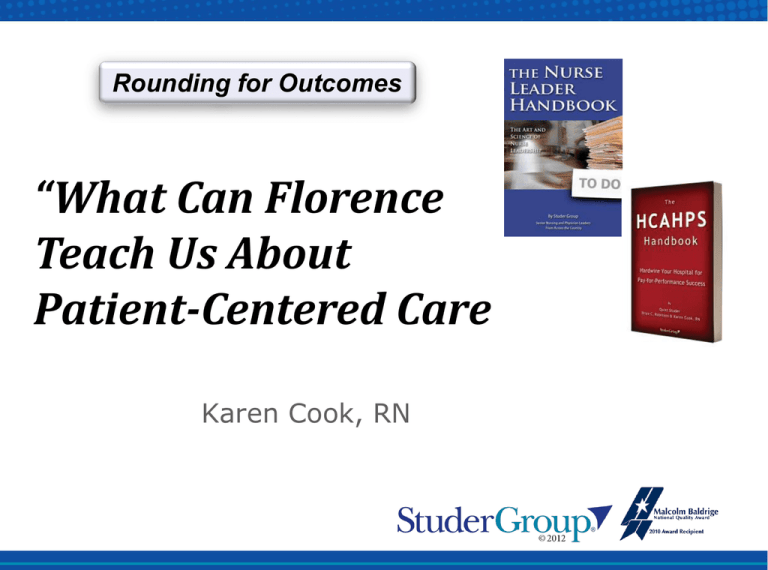
Rounding for Outcomes “What Can Florence Teach Us About Patient-Centered Care Karen Cook, RN Objectives Articulate what is purposeful hourly rounding Describe the behaviors needed to accomplish an effective and purposeful hourly round and bedside handover List strategies to overcome the common barriers to successful hourly rounding and bedside handover Driving Performance Patient-Centered Care Delivery Model Hourly Rounding Bedside Shift Report Nursing and Patient Care Excellence Individualized Patient Care Discharge Phone Calls What Do Staff “Think” About Hourly Rounds? Scripts are fake We don’t have time This is about patient satisfaction not quality Patients get annoyed with us checking on them every hour Logs are stupid Managers don’t care about us, they just care about their dumb reports to the Studer Group What else? Myth #1: Hourly Rounding Was “Invented” By The Studer Group Throughout the night, she would move through the dark hallways carrying a lamp while making her rounds, checking on each patient and providing care if needed. The soldiers were comforted by her compassion, earning her the nickname, "The Lady with the Lamp." Her care would forever change the way hospitals treated patients. Most consider Nightingale the founder of modern nursing. High Reliability Demands Simplicity If we asked five front line staff this question – what would we hear? “What is hourly rounding and why do we do it? What is Hourly Rounding? What is it? A plan to proactively interact with patients every hour during the day using focused key words to assess needs (pain, position, personal needs and patient education) A care model to return care to the bedside, truly patient-centered A plan to help achieve our goal to “always” deliver exceptional clinical quality care in a safe and compassionate environment Why do it? Evidence supports a decrease in patient anxiety, falls, skin breakdown, and nursing steps as well increased patient satisfaction It allows nurses to provide more care at the bedside It reduces anxiety, worry and waiting It is just good patient care There is no other initiative that impacts the patient perception of quality care as this ONE does. Eight Behaviors of Hourly Rounds – More Than 3 P’s Hourly Rounding Behavior Expected Results 1.Use Opening Key words Creates efficiency “checkin’ on ya” won’t suffice 2. Accomplish scheduled tasks Contributes to efficiency 3. Address 3 P’s (pain, potty, position) Quality indicators – falls, decubitis, pain management 4. Address additional comfort needs Improved patient satisfaction on pain, concern and caring, efficiency 5. Conduct environmental assessment and Contributes to efficiency, teamwork ensure bed technology is correctly utilized 6. Ask “Is there anything else I can do for you before I go, I have time?” “Call me if you need me” decreases efficiency. Improves patient satisfaction on teamwork and communication 7. Tell each patient when you will be back Contributes to efficiency 8. Document the round Quality and accountability Myth #2: We Don’t Have Time For Hourly Rounding “I am of certain convinced that the greatest heroes are those who do their duty in the daily grind of domestic affairs whilst the world whirls as a maddening dreidel.” “Notes on Nursing” Florence Nightingale 1854 Track By Low/Solid/High Performers Date: Average call light response time High # of calls Call Rate 25-Jul-12 1:21 3:34 20 26-Jul-12 2:16 5:55 24 6 calls/pt. 2-Aug-12 2:07 5:18 22 5.5 calls/pt. 3-Aug-12 3:15 7:23 17 4.35 calls/pt. 12-Aug-12 4:25 13:53 22 5.5 calls/pt. 14-Aug-12 1:09 3:18 15 3.0 calls/pt. 15-Aug-12 1:12 1:34 13 0.75 calls/pt. 21-Aug-12 1:15 3:18 10 2.0 calls/pt. 22-Aug-12 1:13 3:06 5 1 call/pt. Most Common Reasons for Call Light Use Time is Money $36,660/yr 700 calls/wk= 46 hrs One Call Light = 4 Minutes of Care Giver Time Staff is Already in the Room 0800 1600 0900 1700 1000 1800 1100 1900 1200 2000 1300 2100 1400 2200 1500 14 Myth #3: Hourly Rounding Is Implemented To Improve Patient Satisfaction “The very first requirement in a hospital is that it should do the sick no harm.” “Notes on Nursing” Florence Nightingale 1854 Evidence-Based Quality Responsiveness: Correlates to Quality Responsiveness: Correlates with Readmissions Myth #4: Yup, We Are Doing Hourly Rounding I think one's feelings waste themselves in words; they ought all to be distilled into actions which bring results. “Notes on Nursing” Florence Nightingale 1854 Do Our Words = Results? 88% of Georgia HEN Hospitals report they “ARE doing hourly rounding”… but Georgia ranks 47th out of 50 states in improvement in pain management Georgia Hospitals GA HEN Hospitals Falls GA HEN Hospitals HAPU Correlate Tactic With Results (ROI) Myth # 5 “We have to sign the logs or get written up…we document in the chart so the log is stupid.” “How very little can be done under the spirit of fear.” “Notes on Nursing” Florence Nightingale 1854 Logs Are A Visual for FAMILIES and Patients Are your logs a visual representation of your quality to the patient/family? Do they give you the information you need or are they duplicative charting? Rounding Log Please place your initials in the corresponding time box after round has been complete. **Round is only complete if all 8 Key Behaviors have been done.** 6:00 7:00 8:00 9:00 10:00 11:00 12:00 13:00 14:00 15:00 16:00 17:00 22:0019:00 20:00 21:00 23:00 18:00 MM/DD/YY Sunday Monday Tuesday Wednesday Thursday Friday Saturday Eight Key Behaviors: 1) Use opening key words 2) Perform scheduled tasks 3) Address the 5 P's-Pain, Potty, Position, Possesion, Plan of Care 4) Assess additional comfort needs 5) Conduct environmental assessment 6) Use closing key words and/or actions 7) Explain when you or others will return 8) Document the round on the log Initials: Signature: Initials: Signature: Key: S= Patient Sleeping R = Patient in Radiology E = Room Empty OR = Patient in Surgery P = Procedure in Process CT = Patient in C.T. Department PT = Phyisical Therapy Initials: Signature: Initials: Signature: 1:002:00 3:004:00 5:006:00 Nurse Leaders Round To Ensure Patients “FEEL” Quality Care Nurse leader rounding with targeted questions: Tell me one of the questions that your care team asks you when they come into do their hourly rounds? – We focus on meeting your needs, and with that in mind, the staff are to be in the room every hour asking about pain, position and bathroom needs. Has this been your experience? Have you had to use your call light to ask for pain medicine in the last 24 hours? Tell me what your nurse told you about our process for hourly rounding on this unit? Your Turn Tell us about Hourly Rounding in YOUR hospital… What is working well? Where are there opportunities to improve Hourly Rounding Patient-Centered Care Delivery Model Hourly Rounding Bedside Shift Report Nursing and Patient Care Excellence Individualized Patient Care Discharge Phone Calls Myth #6: Scripting/Key Words Make Us Sound Robotic “Always sit down when a sick person is talking business with you, show no signs of hurry, give complete attention and full consideration… Always sit within view so that when speaking to him, he does not have to painfully turn his head around in order to look at you. If you make this act wearisome, you are doing the patient harm. You cause harm also by continuing to stand to you make him continuously raise his eyes to see you.” “Notes on Nursing” Florence Nightingale 1854 Our Goal is to Deliver Excellent Quality Care Composite Response Scale Nurse courtesy and respect Nurses listen carefully Nurse explanations are clear Doctor courtesy and respect Doctors listen carefully Doctor explanations are clear ALWAYS1, Did you need help in getting to bathroom? 2 Staff helped with bathroom needs Call button answered Yes No (screening question) ALWAYS, Usually, Sometime, Never ALWAYS, Usually, Sometime, Never Pain Management Did you need medicine for pain? 2 Pain well controlled Staff helped patient with pain Yes, No (screening question) ALWAYS, Usually, Sometime, Never ALWAYS, Usually, Sometime, Never Communication of Medications Were you given any new meds? 2 Staff explained medicine Staff clearly described side effects Yes, No (screening question) ALWAYS, Usually, Sometime, Never ALWAYS, Usually, Sometime, Never Did you go home, someone else’s home, or to another facility? 2 Staff discussed help need after discharge Written symptom/health info provided Area around room kept quiet at night Room and bathroom kept clean Willingness to Recommend Own home, Someone else’s home, Another facility (screening question) YES, No YES, No ALWAYS, Usually, Sometime, Never ALWAYS, Usually, Sometime, Never DEFINITELY YES, Probably Yes, Probably No, Definitely No Hospital Rating Question 0 to 10 point scale (percent 9 and 10 reported) Nursing Communication Doctor Communication Responsiveness of Staff Discharge Information Individual Question 1Response 2For Question Summary Usually, Sometime, Never ALWAYS, Usually, Sometime, Never ALWAYS, Usually, Sometime, Never ALWAYS, Usually, Sometime, Never ALWAYS, Usually, Sometime, Never ALWAYS, Usually, Sometime, Never used to calculate the question score is designated by capital letters analysis purposes, it is important to know which areas have screening questions because the sample size will be lower than the other areas Tell the Patient the “Why” of Hourly Rounding “On this unit, one of our care team members will be coming in to see you every hour during the day. You will see either me or Jackie, our certified nurse assistant. I have worked with Jackie for two years and she is excellent. We will be checking on your comfort such as we will make sure we are helping manage any pain you might have, help you change position, help you to the bathroom and make sure you have everything you need.” We call this hourly rounding and we do it to make sure you are safe and we are always meeting your needs.” Have you standardized the process of setting expectations of hourly rounding as part of how you deliver care? How do you know it happens every time? How do the staff explain the logs to the patient and family? WRITTEN Key Words An important part of providing you with individualized care and excellent service is hourly rounding. You will be visited by one of your caregivers EVERY HOUR from 8 a.m. to 10 p.m. And EVERY TWO HOURS from10 p.m. to 8 a.m. During this time we will be: Checking on you and your well-being Monitoring your comfort and pain Helping you move and change positions Attending to personal needs (such as assisting you with toileting, bringing personal items within reach, hygiene needs and anything else to make you more comfortable) Your caregivers also will make sure that you have easy access to the: Telephone, bedside table, water or other beverages, and glasses Urinal and/or bedpan and waste basket Call light for assistance What does this mean to YOU, your family and visitors? It means that we are anticipating your personal needs and monitoring your well-being on an active, hourly basis so that your family and visitors can focus on your recovery. You may receive a survey after you go home. We hope that you will take the time to give us your feedback. We use your feedback to recognize our staff and know how to improve. If you have any concerns, please notify Immediately so we can address them. HOUSTON NORTHWEST MEDICAL CENTER Delivering Clinically Excellent Care Pause Before Leaving “Is This Patient Safe?” Care Boards are FOR the PATIENT Your Turn Tell us some examples of using key words in YOUR hospital… What is working well? Where are there opportunities on your unit to use key words to reduce anxiety? Video Clip Hourly rounding and care boards What worked well What are opportunities for improvement Patient-Centered Care Delivery Model Hourly Rounding Bedside Shift Report Nursing and Patient Care Excellence Individualized Patient Care Discharge Phone Calls Myth # 7 Patients don’t like bedside shift report Apprehension, uncertainty, waiting, expectation, fear of surprise, do a patient more harm than any exertion. “Notes on Nursing” Florence Nightingale 1854 Bedside Shift Report (Handover) What is it? Why is it important? The process of handing-over care delivery from one nurse to another at change of shift at the patient bedside. This process incorporates other concepts such as “managing up”, AIDET communication, teamwork and creating a safe patient environment. All necessary patient information is exchanged in the patient room such as patient identifiers, safety checks, medications, tests etc. This addresses basic patient rights by keeping them patient informed and involved in their care. The patient, and key caregiver/family members are INCLUDED in the conversation as a partner in their care. This process “transfers the trust” to the oncoming caregiver and reduces patient anxiety. Through a real-time exchange of information, the patient is involved in their care as well as teamwork and accountability are strengthened with the caregiver team. It aligns with Magnet and Baldrige criteria and National Patient Safety Goals Bedside Handover Lessons Reinforce the WHY, connect to safe patient care and to nurse satisfaction Address all barriers/resistance in training and ongoing in huddles and other communication Show what RIGHT looks like which includes engaging the patient in their care – not just talking over their bed Train and validate all staff Reward top performance and coach opportunities Track impact and communicate results • Patient satisfaction by unit and HCAHPS – Nurse communication, pain, responsiveness Round on patients to confirm behaviors Post results from rounding – thank you notes Myth #8: We Do Bedside Handover A want of the habit of observing conditions and an inveterate habit of taking averages are each of them often equally misleading. “Notes on Nursing” Florence Nightingale 1854 Other Ways to Validate 1. Directly observe the practice on the unit 2. Leader rounding on patients Verify bedside handover is occurring by asking patients and their families 3. Leader rounding on staff Ask them what is working well Highlight a WIN during Huddles 4. Discharge phone calls or survey 5. RESULTS – especially nurse communication Myth # 9: Management is in charge of how we deliver care “Let whoever is in charge keep this simple question in her head (not, how can I always do this right thing myself, but) how can I provide for this right thing to be always done?” “Notes on Nursing” Florence Nightingale 1854 Myth #10: It won’t work on our unit “I attribute my success to this - I never gave or took any excuse.” ― Florence Nightingale Thank Your For All YOU Do “Were there none who were discontented with what they have, the world would never reach anything better.”― Florence Nightingale, Notes on Nursing: What It Is, and What It Is Not
